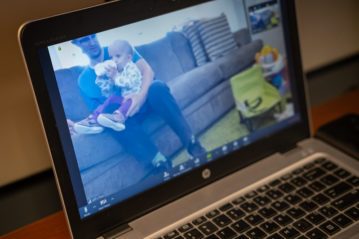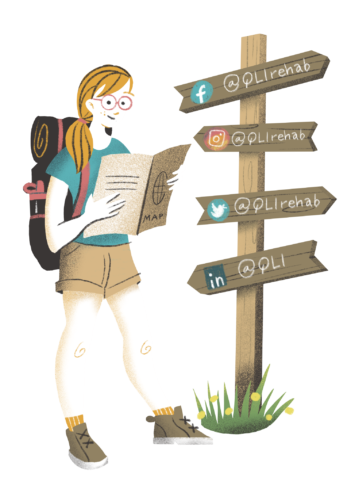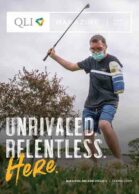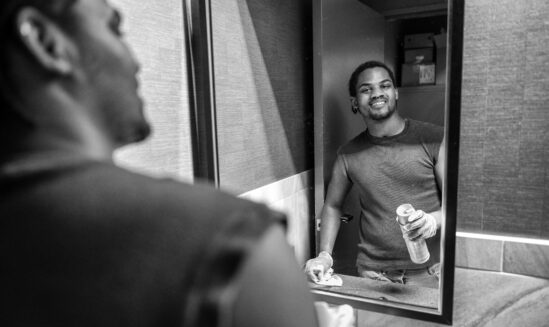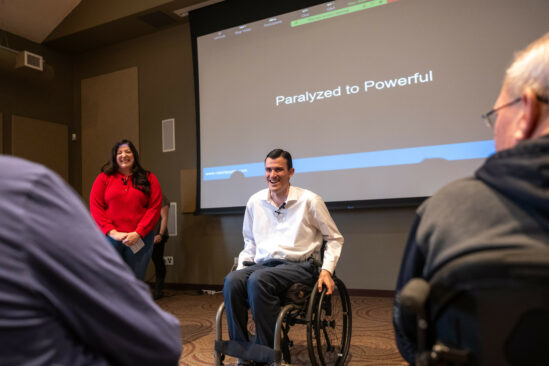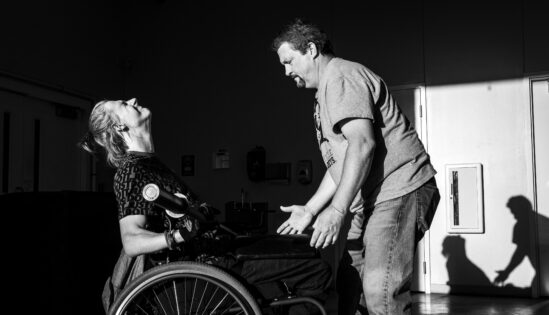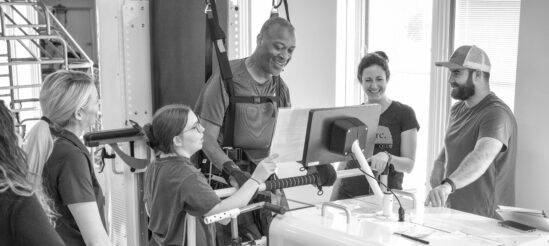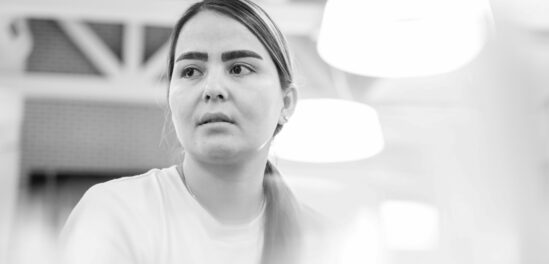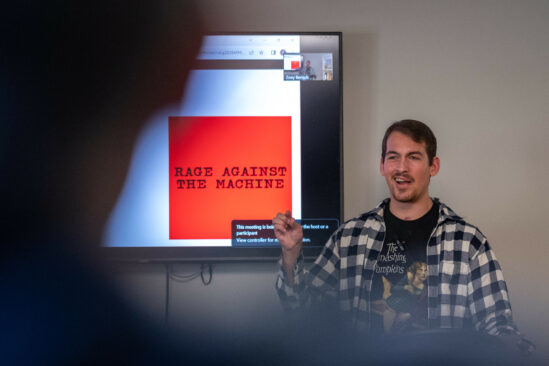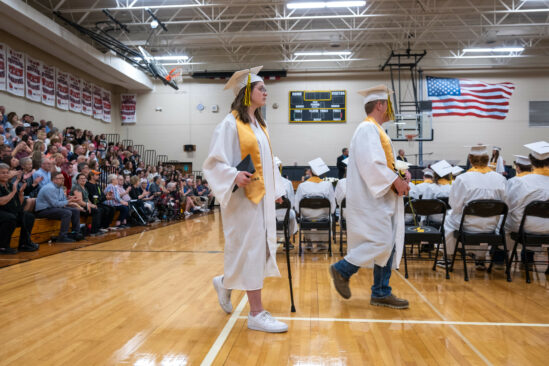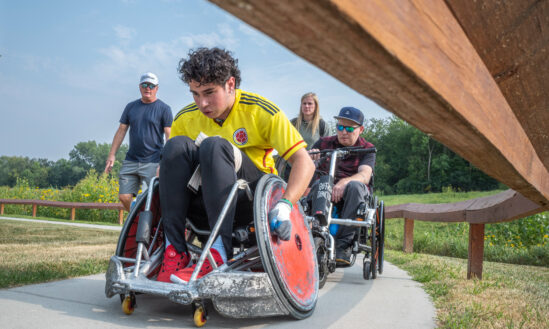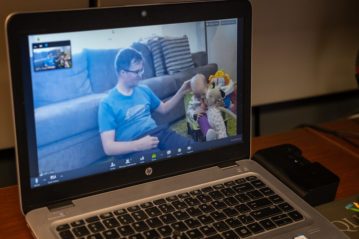 Today, Jeff Griffin is playing with his daughter, Leta.
Today, Jeff Griffin is playing with his daughter, Leta.
The one-year-old blazes into the living room, half-sprint and half-waddle, right to the spot where Jeff sits on the carpet. She carries with her a big plastic sheet cake cover, the translucent kind you might see protecting the top of a store-bought birthday cake. It makes a fun warbling noise when whipped back and forth, or when you do what Leta does and slap it open-palmed like you’re beating a drum.
Jeff peers through the panel at her. They lock eyes, sharing a moment of recognition before Leta smiles and laughs, as though her dad has just helped her discover a new lens through which to see the living room. She holds the sheet with both hands and glasses over her purview. Jeff braces her at her hips as she pivots in place.
Outside, Jeff’s Colorado suburb has gone quiet. A statewide stay-at-home order issued by Colorado Governor Jared Polis keeps families isolated from jobs and daycare centers and all non-grocery businesses. The order is just the latest in a weeks-long effort to combat the rapid spread of COVID-19.
But inside, Jeff is far from inert. He sings to his daughter, scribbles notes in a journal about webinars and lectures he watches online, and maintains a surprisingly strenuous in-home exercise routine to challenge his cardiovascular endurance and general flexibility.
This isn’t the busywork of a man home from the job. This is therapy. In fact, there’s a therapist watching his interaction with Leta right now.
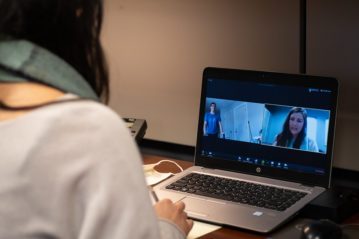 “Nice job, Jeff,” occupational therapist Melissa Anderson says, “Your attention to her is really impressive. You’re doing awesome.”
“Nice job, Jeff,” occupational therapist Melissa Anderson says, “Your attention to her is really impressive. You’re doing awesome.”
Though more than 500 miles away, seated in an office chair in a quiet space on QLI’s Rehabilitation Campus, Melissa is present in Jeff’s living room—the result of a livestream broadcast directly to Jeff’s iPad. She oversees just one of the day’s numerous scheduled sessions he has as a participant of QLI’s Telerehabilitation program, a technology-driven service that connects individuals recovering from brain injuries, spinal cord injuries, or strokes with QLI clinical experts from afar.
Multiple times a day, every day, he logs in and meets with a clinician from QLI. Someone who will help him on the journey to regain things lost to catastrophe.
At a glance, Jeff might not look like someone who has endured a diffuse axonal brain injury and multiple small strokes, and yet, he’s been in and out of hospitals and rehabilitation centers and outpatient clinics for more than a year. The injury continues to redefine his life.
“It affected everything, really,” says Brittany Barnett, Jeff’s partner. She recounts seeing the MRI scans of his brain, describing a “blackout” in the areas that controlled his movement.
“Our goals from the outset were to hit everything that changed physically. You know, get him walking again. But really addressing things like his memory, too. His problem-solving. Prompting him to do certain things when there’s nothing going on.”
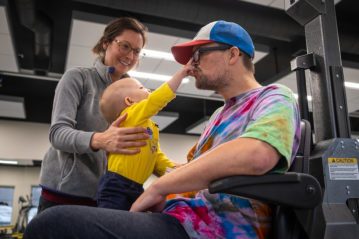 For a time, Jeff improved on a steady incline. Early therapies and the intensive inpatient programming at QLI helped him pass small milestones at regular intervals. Clinicians targeted the finer nuances of his burgeoning skills—his clarity of thought, clarity of speech, and the ability to walk without the use of a wheelchair or, later, even a walker—while still incorporating relevant big-picture elements of his life.
For a time, Jeff improved on a steady incline. Early therapies and the intensive inpatient programming at QLI helped him pass small milestones at regular intervals. Clinicians targeted the finer nuances of his burgeoning skills—his clarity of thought, clarity of speech, and the ability to walk without the use of a wheelchair or, later, even a walker—while still incorporating relevant big-picture elements of his life.
But after returning home in December 2019, things changed. He struggled in his local outpatient clinic, where his growing confidence and freshly obtained skills weren’t appropriately challenged.
“We saw him regress pretty rapidly,” Brittany says. “It felt like we were watching him lose months of progress and we just didn’t understand why. He’d come home walking so well, doing so well. Why isn’t he still moving forward?”
The conundrum troubled Jeff’s QLI team too, which, despite no longer providing treatment for him, kept regular contact with Brittany. Rather than see a progression of developing goals and achievements, his QLI team watched helplessly from a state away as Jeff’s physical independence withered. He had gone from walking without assistance back to reliance on a rollator walker. His daily routine lacked structure and guidance. His life had become, suddenly, a disconnected thing, lacking meaningful connections to his passions, his friends, or his deepest relationships.
Given the circumstances, QLI was quick to offer an alternative: a new telerehabilitation service separate from QLI proper, but still built on the foundation—and with the same team members—responsible for many of Jeff’s successes just months before.
Brittany responded to the proposal with optimism and justified skepticism. After all, part of what made Jeff’s time at QLI so successful was the sheer level of involvement his clinicians committed to his program. There, every second of Jeff’s day was the product of meticulous orchestration, engineered to propel him toward regular cognitive and physical gains.
It seemed unlikely that a similar approach was feasible at a distance.
In truth, Jeff’s QLI Telerehabilitation battle plan effectively mirrored the experience delivered by QLI just months earlier. His weekly schedule ballooned with one-on-one training sessions hosted by experts from a variety of disciplines. Physical therapy, occupational therapy, speech-language pathology and cognitive training, even psychological and emotional support.
While QLI Telerehabilitation came to Jeff via phone or iPad, it was every bit as comprehensive as his therapy in Omaha.
“Frankly,” Brittany says, half-laughing, “the word to describe it would be ‘exhausting.’”
And after only a few weeks, added benefits of the format began to surface.
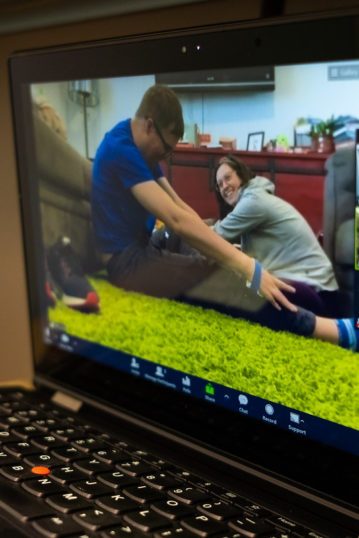 Now removed from the neutral space of a therapy clinic, Jeff’s QLI Telerehabilitation team could assess his needs in the most practical environment of all: home. The change of environment meant a commensurate change in depth.
Now removed from the neutral space of a therapy clinic, Jeff’s QLI Telerehabilitation team could assess his needs in the most practical environment of all: home. The change of environment meant a commensurate change in depth.
Speech therapy didn’t simply treat word-finding issues; it became an all-hands-on-deck effort to coach Jeff through receiving, interpreting, and retransmitting complex information, a crucial skill he would use every day in actual conversation. Occupational therapy, likewise, guided Jeff toward functional daily routines he could complete without assistance or supervision. Grooming and getting dressed in the morning, for instance. Or cooking with his ingredients using his kitchenware on his own stovetop. And while muscular strength and range of motion were key to Jeff’s physical therapy, his ability to safely and independently apply these skills in real locations—say, getting up off the living room floor after a play session with his daughter—became the true anchorpoint of his renewed physical progress.
Jeff’s previous therapies required an element of translation. He was responsible for retaining skills from an unfamiliar environment into the one he knew. QLI Telerehabilitation removed the translation altogether. Instead, it combined guided learning and functional application in the place that mattered most, the one in which he would perform most of his everyday activities.
“This is simply more realistic,” says Brittany. “I mean, we’re not talking about rehab anymore. We’re talking about ‘How do you live?’”
Living is the confluence of ability and interest, the intersection between what you want to do, how you are able to do it, and who you want to do it with.
The very values, it seems, threatened by the sweeping presence of COVID-19.
Despite the outside world existing in a state of suspended animation, Jeff logs in to his QLI Telerehabilitation appointments. Jeff can’t travel to his neighborhood recreation center, he can’t participate in his new volunteer position at the city food bank. But still his therapists keep their appointments—sometimes from the office, sometimes from home themselves.
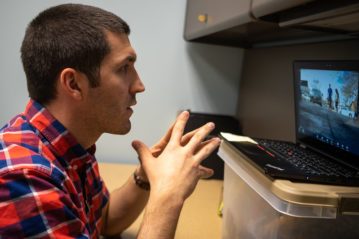 With their supervision, he practices proper gait technique, supported only by the aluminum railing stretching the length of his garage. Or, with his speech therapist, he practices cognitive organization by building outlines out of notes scribbled from TED Talks he finds interesting.
With their supervision, he practices proper gait technique, supported only by the aluminum railing stretching the length of his garage. Or, with his speech therapist, he practices cognitive organization by building outlines out of notes scribbled from TED Talks he finds interesting.
It is when Leta gets involved, however, that Jeff’s personality shines through brightest. He’s a patient, seemingly unflappable father. His adoration for Leta seems matched only by his excitement to keep her engaged. Before an early morning hour of play, he strategizes with QLI’s Melissa Anderson to capture his daughter’s attention.
“She really like to clap,” Jeff says.
“That’s a great start,” Melissa affirms. “Let’s think of some songs we can sing that involve clapping.”
A couple songs spring to mind. One is the old nursery rhyme, “Pat-A-Cake, Pat-A-Cake.” Melissa and Jeff decide to drop the traditional clapping game in favor of clapping with every beat of emphasis.
Jeff, with iPad in hand, joins Leta as she plays with toys in the living room. Jeff slowly lowers himself to the floor, using a practiced tactic he picked up from a recent physical therapy session. Without hesitation he begins to sing.
Just as expected, it’s the clapping that gets Leta’s attention. A big smile lights up her face. A big one lights up Jeff’s, too.
There in the center of the living room floor, Leta is Jeff’s tiny mirror image. She follows his movements, she bounces on her feet, she vocalizes in the middle of his singing. Sometimes she claps in time with her father, but more often she smacks her hands together quickly, without rhythm, and lets out a hearty laugh. They watch each other all the while.
Eventually, it’s time for Leta to have her bottle. She holds it with both hands and clambers into her father’s lap. He’s now a makeshift pillow for a happy toddler. When Jeff looks at her, it’s as if he’s seeing more than a child, but a purpose. A future. One that might not have existed without this specialized form of therapy.
From the iPad, Melissa jokes that Leta looks comfortable, that Jeff had better not move. Jeff, never taking his eyes off his daughter, responds with a big laugh.
“Oh, definitely,” he says. “She’s the boss now.”
